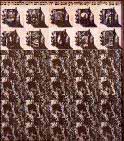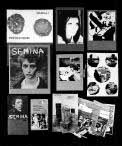
|
 "Semina", volumes I-IX, offset |
by Andy Brumer
People generally associate the Beat Generation more with literature and poetry than with visual art. Last year's exhibition at the Whitney Musuem of American Art did its best to alter that perception, though even much of the work featured there was produced by Allen Ginsberg, Lawrence Ferlinghetti, Michael McClure, and other writers with whom the Beat Generation is most widely identified.
What may be perceived as somewhat ironic in this regard is that these same writers, in addition to dabbling in visual art themselves, greatly admired, if not idolized certain painters, perhaps finding in their work a kind of primal and direct sense of self-expression toward which their own writing aspired. Wallace Berman was one of the Beat artists most admired by his peers and, as this show displays, with very good reason.
The exhibition does not attempt to reveal Berman's achievement in a new light. Rather, it dons the modest task of reinforcing its influence not only on the Beats, but on American art and pop culture images and directions that would follow.

|
 "Semina", volumes I-IX, offset |
Berman died in Topanga Canyon in 1976 at the age of fifty. His art embodied the kind of interdisciplinary leanings and interests that, in time, would come to help characterize the Beat movement as a whole. In addition to his art, Berman wrote poetry, composed rhythm and blues tunes, and collaborated, at one time, with legendary bluesman Jimmy Wither-spoon.
In the present show a selection of Berman's verifax collages, for which he is best known, are the headliners. (see UNTITLED) Berman produced these poetic and softly sepia-toned works with an early-day copy machine. In them he repeats an image of a hand-held transistor radio whose flat front surface becomes a screen that holds an array of images. On the one hand, these images come from the readily identifiable world of pop (football players, an astronaut) or prosaic (a lock and key, a little girl) culture. (see UNTITLED - 1963 for other popular-culture subjects) Others emit more mystical signals and symbols (a cross, a rabbit's foot, a snake, Hebrew letters, a folded rose). Indeed, the radio declares itself a symbol in its own right for the endless, and at first glance, disparately irrational "transmission" of images which the unconscious mind is capable of producing. (see also UNTITLED - 1987)
Placed around the border of at least one piece are Hebrew letters that call attention to Berman's interest in Jewish mysticism, specifically the Cabbala, a text which itself required a scholarly and creative deciphering of arcane signs and symbols. (see also UNTITLED - 1973) In that any alphabet may be construed as an ordinary "object," the lettering in these verifax works further Berman's intention of wedding quotidian and spiritually charged experience and potentialities.
The exhibition also includes exact replicas of SEMINA, a "mail art scrapbook," as one writer described these folio assemblage packages that Berman published in limited editions and sent to friends. (see also DETAIL FROM SEMINA) Organized in intriguing and variously shaped envelopes and/or bindings, Semina contains works by poets such as Michael McClure, Philip Lamantia, David Meltzer, as well as Berman's own artwork and poetry, which he published under the pseudonym Pantale Xantos.